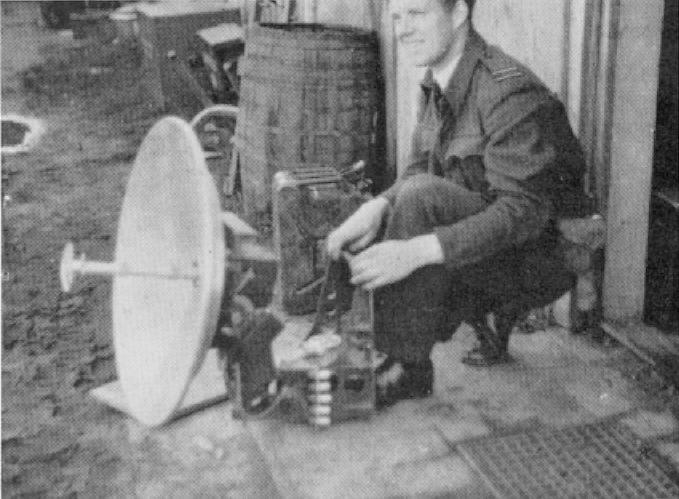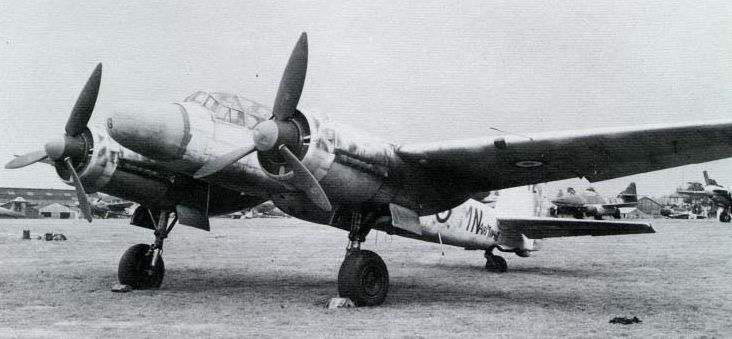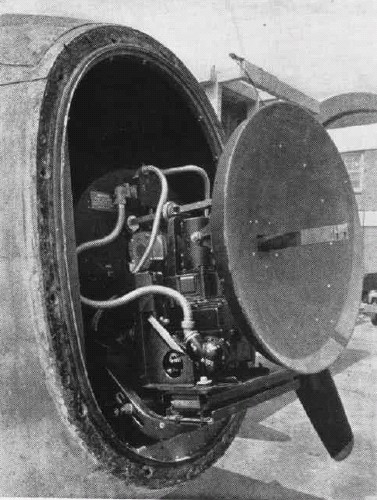FuG 240 Berlin on:
[Wikipedia]
[Google]
[Amazon]

 The FuG 240 "Berlin" was an airborne interception radar system operating at the "lowest end" of the SHF radio band (at about 3.3
The FuG 240 "Berlin" was an airborne interception radar system operating at the "lowest end" of the SHF radio band (at about 3.3
 The Berlin N-2 model was installed primarily in
The Berlin N-2 model was installed primarily in 
"The Century of Radar"
EADS Deutschland *Larry Belmont
{{German radars of World War II Aircraft radars World War II German radars Military equipment introduced from 1945 to 1949

GHz
The hertz (symbol: Hz) is the unit of frequency in the International System of Units (SI), equivalent to one event (or cycle) per second. The hertz is an SI derived unit whose expression in terms of SI base units is s−1, meaning that one he ...
/9.1 cm wavelength), which the German Luftwaffe
The ''Luftwaffe'' () was the aerial-warfare branch of the German ''Wehrmacht'' before and during World War II. Germany's military air arms during World War I, the ''Luftstreitkräfte'' of the Imperial Army and the '' Marine-Fliegerabtei ...
introduced at the very end of World War II
World War II or the Second World War, often abbreviated as WWII or WW2, was a world war that lasted from 1939 to 1945. It involved the vast majority of the world's countries—including all of the great powers—forming two opposin ...
. It was the first German radar to be based on the cavity magnetron
The cavity magnetron is a high-power vacuum tube used in early radar systems and currently in microwave ovens and linear particle accelerators. It generates microwaves using the interaction of a stream of electrons with a magnetic field while ...
, which eliminated the need for the large multiple dipole
In physics, a dipole () is an electromagnetic phenomenon which occurs in two ways:
*An electric dipole deals with the separation of the positive and negative electric charges found in any electromagnetic system. A simple example of this system i ...
-based antenna arrays seen on earlier radars, thereby greatly increasing the performance of the night fighter
A night fighter (also known as all-weather fighter or all-weather interceptor for a period of time after the Second World War) is a fighter aircraft adapted for use at night or in other times of bad visibility. Night fighters began to be used i ...
s. Introduced by Telefunken
Telefunken was a German radio and television apparatus company, founded in Berlin in 1903, as a joint venture of Siemens & Halske and the ''Allgemeine Elektrizitäts-Gesellschaft'' (AEG) ('General electricity company').
The name "Telefunken" app ...
in April 1945, only about 25 units saw service.
Background
The GermanLuftwaffe
The ''Luftwaffe'' () was the aerial-warfare branch of the German ''Wehrmacht'' before and during World War II. Germany's military air arms during World War I, the ''Luftstreitkräfte'' of the Imperial Army and the '' Marine-Fliegerabtei ...
first introduced an airborne interception radar in 1942, the FuG 202 "Lichtenstein B/C" and its direct follow-on version, the FuG 212 Lichtenstein C-1. Both units operated at 490MHz, in the low UHF
Ultra high frequency (UHF) is the ITU designation for radio frequencies in the range between 300 megahertz (MHz) and 3 gigahertz (GHz), also known as the decimetre band as the wavelengths range from one meter to one tenth of a meter (on ...
band with a wavelength of 0.61 meter. Radar antennas are sized roughly to the operational wavelength, or a fraction thereof, so the FuG 202 and 212 initially required large, 32-dipole ''Matratze'' (mattress) antenna arrays that projected in front of the aircraft and caused considerable drag - this was later reduced to a one-quarter subset of the same antenna design, centrally mounted on the aircraft's nose.
By 1943 a series of efforts and lucky intercepts had allowed the Royal Air Force
The Royal Air Force (RAF) is the United Kingdom's air and space force. It was formed towards the end of the First World War on 1 April 1918, becoming the first independent air force in the world, by regrouping the Royal Flying Corps (RFC) and ...
to introduce jammers
Jammer may refer to:
Signal blocking devices
* Radar jammer, a device used in radar jamming and deception
* Radio jammer, a device used in radio jamming
* Radio-controlled Improvised Explosive Device jammer, a counter-IED device
* Mobile phone ...
, which interfered with the AI radar's operation. The RAF also introduced the Serrate radar detector Serrate was a World War II Allied radar detection and homing device used by night fighters to track Luftwaffe night fighters equipped with the earlier UHF-band ''BC'' and ''C-1'' versions of the Lichtenstein radar. It allowed RAF night fighters to ...
, which allowed British night fighters to home in on the Lichtenstein radars. Over the summer and fall of 1943, the RAF downed an impressive number of German night fighters.
The Luftwaffe responded by introducing the FuG 220 Lichtenstein SN-2 in late 1943. To avoid RAF jamming, the SN-2 operated in the low-VHF range, at 90MHz, or 3.33 meter wavelength. The SN-2's lower frequency range required enormous eight-dipole ''Hirschgeweih'' (stag's antlers) antennas, which created so much drag that aircraft were slowed by some 50 km/hour.
The Lichtenstein SN-2 was eventually supplanted by the Neptun radar
(Neptune) was the code name of a series of low-to-mid-VHF band airborne intercept radar devices developed by Germany in World War II and used as active targeting devices in several types of aircraft. They were usually combined with a "backwards ...
. Based on the same basic technology as the Lichtenstein, the Neptun operated on six mid-VHF frequencies between 158-187MHz. with shorter dipole antennas, still in the "antler" mounting format. This unit was only a stop-gap solution.
Rotterdam Device
TheRoyal Air Force
The Royal Air Force (RAF) is the United Kingdom's air and space force. It was formed towards the end of the First World War on 1 April 1918, becoming the first independent air force in the world, by regrouping the Royal Flying Corps (RFC) and ...
's first Airborne Intercept radars operated in the 1.5 meter band and featured antennas similar to their later German counterparts. However, the introduction of the cavity magnetron
The cavity magnetron is a high-power vacuum tube used in early radar systems and currently in microwave ovens and linear particle accelerators. It generates microwaves using the interaction of a stream of electrons with a magnetic field while ...
in 1940 changed things dramatically. The magnetron efficiently generated microwave
Microwave is a form of electromagnetic radiation with wavelengths ranging from about one meter to one millimeter corresponding to frequencies between 300 MHz and 300 GHz respectively. Different sources define different frequency ran ...
s from a device the size of a coffee tin, lowering operational wavelengths from the several-meter range to less than 10 centimeters. This reduced the antenna size to a few centimeters. Instead of simply using a smaller Yagi antenna Yagi may refer to:
Places
*Yagi, Kyoto, in Japan
*Yagi (Kashihara), in Nara Prefecture, Japan
*Yagi-nishiguchi Station, in Kashihara, Nara, Japan
*Kami-Yagi Station, a JR-West Kabe Line station located in 3-chōme, Yagi, Asaminami-ku, Hiroshima, Hi ...
, the system was paired with a new parabolic dish
A parabolic (or paraboloid or paraboloidal) reflector (or dish or mirror) is a reflective surface used to collect or project energy such as light, sound, or radio waves. Its shape is part of a circular paraboloid, that is, the surface generated ...
which allowed for conical scanning
Conical scanning is a system used in early radar units to improve their accuracy, as well as making it easier to steer the antenna properly to point at a target. Conical scanning is similar in concept to the earlier lobe switching concept used o ...
. The result was a small, lightweight, powerful, long range and easy to read radar.
The magnetron was initially limited to aircraft operating over the UK or sea, so that if the aircraft was lost the magnetron would not fall into German hands. However, as the war progressed several new uses for the magnetron were developed, notably ground-mapping systems like the H2S radar
H2S was the first airborne, ground scanning radar system. It was developed for the Royal Air Force's Bomber Command during World War II to identify targets on the ground for night and all-weather bombing. This allowed attacks outside the range ...
. These allowed the operator to obtain a crude cathode ray tube
A cathode-ray tube (CRT) is a vacuum tube containing one or more electron guns, which emit electron beams that are manipulated to display images on a phosphorescent screen. The images may represent electrical waveforms ( oscilloscope), pictu ...
image of the ground below in any weather. This was of great use to RAF Bomber Command
RAF Bomber Command controlled the Royal Air Force's bomber forces from 1936 to 1968. Along with the United States Army Air Forces, it played the central role in the strategic bombing of Germany in World War II. From 1942 onward, the British bo ...
's efforts, and an intense debate broke out over whether to allow its use over continental Europe. In the end the decision was taken to allow H2S units in strategic operations, starting with the Pathfinder Force
The Pathfinders were target-marking squadrons in RAF Bomber Command during World War II. They located and marked targets with flares, which a main bomber force could aim at, increasing the accuracy of their bombing. The Pathfinders were norma ...
.
The inevitable occurred on 2 February 1943, when a Short Stirling
The Short Stirling was a British four-engined heavy bomber of the Second World War. It has the distinction of being the first four-engined bomber to be introduced into service with the Royal Air Force (RAF).
The Stirling was designed during t ...
Pathfinder was downed near Rotterdam
Rotterdam ( , , , lit. ''The Dam on the River Rotte'') is the second largest city and municipality in the Netherlands. It is in the province of South Holland, part of the North Sea mouth of the Rhine–Meuse–Scheldt delta, via the ''"N ...
. German forces examining the wreckage found an apparatus which they called the "Rotterdam Gerät" (Rotterdam Device). They quickly determined it to be a centimeter wavelength generator, although its exact purpose was unclear. This was revealed when a second example was captured, and the crew of the aircraft revealed it to be a mapping system. Wolfgang Martini
''Wolfgang Martini'' (September 20, 1891 – January 6, 1963) was a Career Officer in the German Air Force and largely responsible for promoting early radar development and utilization in that country.
Early career
While attending the Gymnasium ...
immediately set up a team to understand the new system and devise countermeasures. This work led to the FuG 350 ''Naxos'' device, a radio receiver using a DF loop for an aircraft installation, covered with a teardrop-shaped fairing and tuned to the H2S frequencies, that was used to track the Pathfinders in flight. However, this was introduced just as the RAF was introducing the H2S Mk. III and the US their H2X radar
H2X, officially known as the AN/APS-15, was an American ground scanning radar system used for blind bombing during World War II. It was a development of the British H2S radar, the first ground mapping radar to be used in combat. It was also known ...
, which operated at 3 cm (10 GHz) and thus was not seen by ''Naxos''.
Berlin
The captured magnetron was sent to Berlin and a group assembled from the German electronics industry met at theTelefunken
Telefunken was a German radio and television apparatus company, founded in Berlin in 1903, as a joint venture of Siemens & Halske and the ''Allgemeine Elektrizitäts-Gesellschaft'' (AEG) ('General electricity company').
The name "Telefunken" app ...
offices to discuss it. Only days later those offices were attacked and the magnetron was destroyed. However, a second example was recovered from an aircraft taking part in that raid.
Telefunken used it as a basis for a German version of the device and an AI radar based on it. The system which Telefunken developed was similar to its British counterpart, differing largely in the display system. Given the limited number of changes, it is unclear why it took so long to get into production, over two years. Production units were not ready until the spring of 1945, and were not installed in German aircraft until April, just before the war ended.
 The Berlin N-2 model was installed primarily in
The Berlin N-2 model was installed primarily in Junkers Ju 88G-6
The Junkers Ju 88 is a German World War II ''Luftwaffe'' twin-engined multirole combat aircraft. Junkers Aircraft and Motor Works (JFM) designed the plane in the mid-1930s as a so-called ''Schnellbomber'' ("fast bomber") that would be too fast ...
night-fighters, behind a plywood radome
A radome (a portmanteau of radar and dome) is a structural, weatherproof enclosure that protects a radar antenna (radio), antenna. The radome is constructed of material transparent to radio waves. Radomes protect the antenna from weather and ...
. This so greatly reduced drag compared to the late-model Lichtensteins and Neptun that the fighters regained their pre-radar speeds. The power output of the N-2 radar was 15 kW, and was effective against bomber-sized targets at distances of up to 9 kilometers, or down to 0.5 kilometer, which eliminated the need for a second short-range radar system. The N-3 version used an updated display system that featured a C-scope
A radar display is an electronic device to present radar data to the operator. The radar system transmits pulses or continuous waves of electromagnetic radiation, a small portion of which backscatter off targets (intended or otherwise) and retur ...
output, which simplified the intercept.
The N-4 was a further development of the N-3; it rotated the antenna in the horizontal plane under an FuG 350 ''Naxos''-antenna style teardrop housing atop the aircraft fuselage. The result was a 360-degree image of the sky around the aircraft that was presented on a plan position indicator
A plan position indicator (PPI) is a type of radar display that represents the radar antenna in the center of the display, with the distance from it and height above ground drawn as concentric circles. As the radar antenna rotates, a radial tra ...
(PPI). This version was later renamed the FuG 244 "Bremen", but was not approved for production.

Technical specifications
*Power: 15kW *Search angle: +/− 55° *Antenna diameter: 0.70 meter *Frequency range: 3,250–3,330MHz (~10 cm) *Range: 0.5–9.0 kilometerExternal links
*Wolfgang Holpp"The Century of Radar"
EADS Deutschland *Larry Belmont
{{German radars of World War II Aircraft radars World War II German radars Military equipment introduced from 1945 to 1949